Long Term Review
Santa Cruz Bronson CC
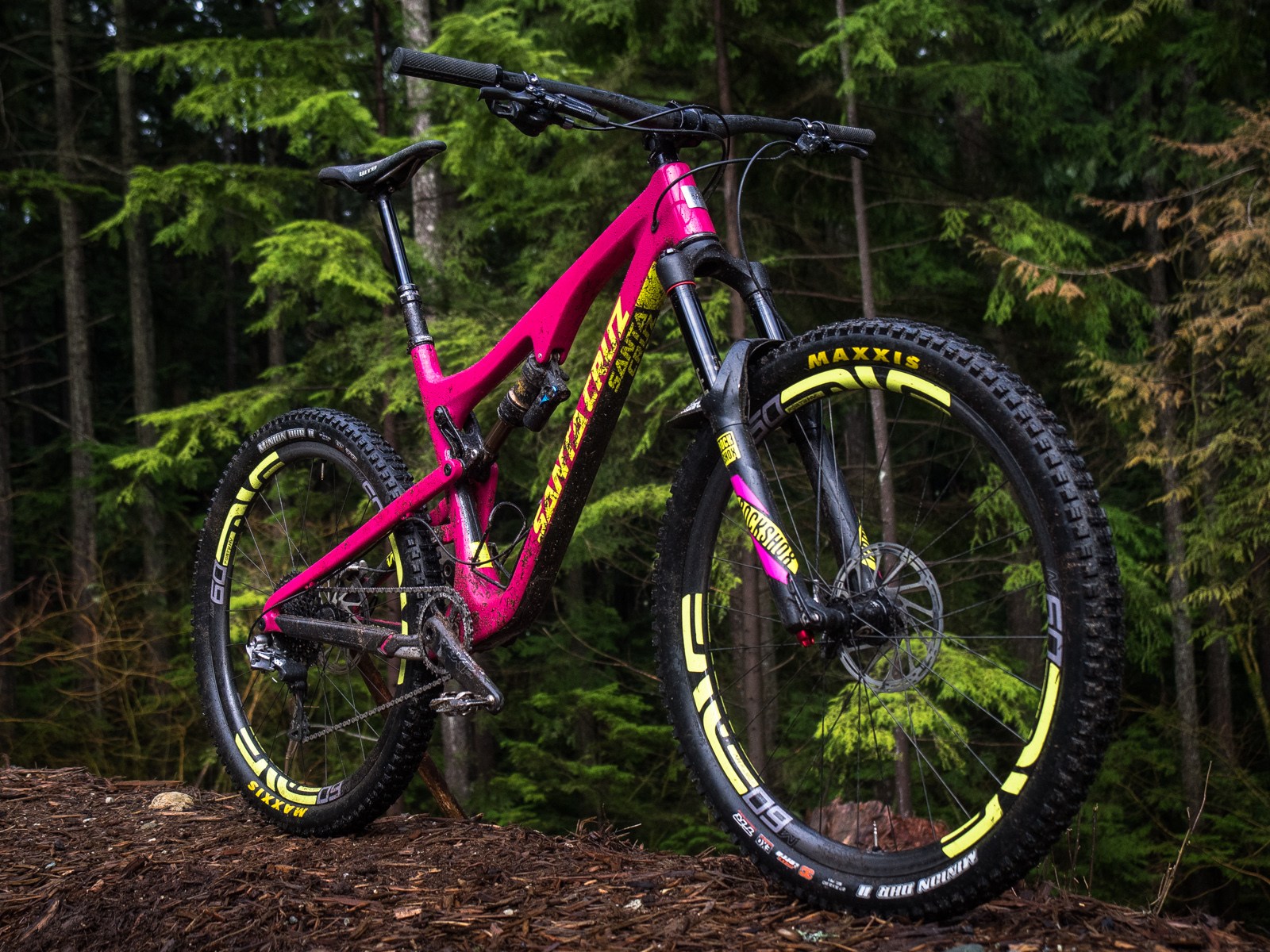
I’ve been on the new Santa Cruz Bronson for a couple of months now; sloshing through a soggy northwest winter, getting to know the magenta wonderbike. It’s been a happy-making machine; time to have an in-depth look at how it worked for me. If you’re looking for specifications, geometry, and detailed bike pictures, have a gander at the First Impressions article.
The build is fairly dialed out of the box; impressively, there’s not a thing I felt compelled to change. Here’s the component rundown:
Creature comforts: The Santa Cruz carbon bar is a proper 800mm wide – one size fits all (with application of hacksaw if need be), and I liked the bend. Grips are also house brand – they’re single clamp, with a small diameter knurled pattern that feel good to these hands. The 50mm Easton Haven stem was spot on for the moderately long reach (450mm on the large frame). The WTB Silverado saddle fits my posterior physiology well, and the attached Rockshox Reverb Stealth did its uppy-downy routine reliably.
Into the gnarled dark heart of the North Shore where old ghosts lie in melancholic repose. Or something vaguely poetic. Here I realized how rusty my skinny skills are.
Brakes: I really like the new Guide Ultimate stoppers. The shorty lever is similar to the Shimano shape (which I love). The lever reach and pad throw adjustments are easy to use and effective. The engagement bite isn’t quite as aggressive as said Shimanos, lending easy modulation. Power is quite good – though I’d prefer a 200mm front rotor over the stock 180mm unit. Braking was fade-free, and lever reach remained consistent on long continual applications. Good stuff.
Drivetrain: Until this year, I’ve been a loyal Shimano customer. I’m now sold on the efficacy of SRAM 1x with one minor gripe – I miss the Shimano trigger upshift capability (SRAM is push-push only). That said, the XX1 drivetrain shifted flawlessly up and down the 10-42 block for the entire test period with nary an adjustment. Solid. The 32T Raceface narrow-wide ring also did its chain retaining duties diligently. The Next SL carbon cranks are stiff and silly light but are looking a bit haggard from shoe scuffing. Applying a bit of frame protector might be in order if you’re concerned about such things.
Damn trees, always getting in the shot. And my head is cropped right out. What the hell, Dave? Am I that hideous?
Wheels: The Enve-rimmed Industry Nine-hubbed wheelset is trick indeed. They’re certainly light, noticeably stiff, and make really cool sounds – I9 subscribes to the more is better school of engagement points. The 26mm internal width HV (“High Volume”) rim offers good support for the Maxxis Minion DHR EXO 2.4 tires – set up tubeless; I was running pressures around 22F / 25R with no burping. I’m not fond of the internal nipple design, despite the argument that the smaller holes create a stronger rim. Peeling off a tire and rim strip to tighten a nipple? No thanks. That said, the wheels did hold their tension throughout the test, requiring nary a twiddle, which is impressive.
I did, however, have an issue with the bearings in the I9 hubs. After a couple months of Wetcoast riding, the front hub is feeling a little rough, but the rear feels like it’s full of gravel. A bad set of bearings, perhaps – they’re Enduro (the company, not the overused marketing term), which I assumed to be decent quality. I’ve never had a high-end hub give up its guts in such short order, though.
These are the first Enve wheels I’ve ridden and I was excited to experience the juju. I’ve run aluminum wheelsets of similar weight, so acceleration was not different – they’re definitely quick to spin up. The increase in stiffness was notable, however – they seemed to ping off impacts with a bit more energy and deflect less in hard corners. I’m not totally sold on the stiffer is better school of thought, so I’ll just leave it at “discernibly different”. Rim durability seems quite good; I’m not a wheel crusher by any means, but do pick up dents in aluminum rims on a semi-regular basis. These saw a few hard pings without damage. So; worth a $2k upgrade over the standard aluminum rimmed wheelset? Not in my world, but if you have the disposable income, and bling is your thing, they certainly get the job done (questionable bearing durability notwithstanding).
Occasionally there are brief opportunites for speed in these forests.
Frame details: I’ll take a moment to commend the ability to run a large size water bottle in a properly accessible location; cheers, designer guy. Frame protection – downtube and chainstay – is well integrated and effective. Cable routing is rattle free and clean though there is a brake line wear point on the seat tube. Again, if such things worry you, break out that roll of frame saver. I didn’t have to replace any lines, but the fully guided internal routing is a nice touch; great not having to fish for cables in the dark depths of a down tube.
The swingarm sports copious tire clearance; no mud issues there. The newly relocated bottom link (that tucks into a pocket above the BB) does accumulate mud, but there seemed to be no ill effects to the pivot bearings. Nearly every ride these days is a wet one, and that mud shelf gets hosed out each time. I recently pulled the pivot apart to have a look, and things are clean & running smoothly. No play or sign of bearing wear. Very nicely designed, well-sealed hardware. For what it’s worth, SC offers a lifetime warranty on said bearings – an impressive testament to the confidence they have in these bits.
Dampers: The boingy bits were surprisingly easy to get sorted to my liking. I run a Pike on my daily driver, so was already familiar with twiddling this device, and had it in my sweet spot in short order. I like the fork; supple, yet well supported, and a decently stiff chassis for the weight. The Fox Float X Factory shock – with Evol air can & Kashima coated shaft – was new to me, but was similarly easy to get into my happy place. We’ll talk a bit more about the shock later.
Between a hard place and another hard place. It’s really not a bad place to be.
Now, on to the riding!
Going up: At 27.7lbs (size large with pedals) it’s certainly svelte, and the response to pedal input was impressive – no doubt owing in large part to the carbon hooped Enve wheelset. Also noticeable was the improvement in the pedaling platform over the previous Bronson. Nice support at the sag point and minimal pedal induced bob (ie, decent anti-squat) meant I ended up leaving the 3-position compression adjustment lever on the Fox shock at full open all the time.
An efficient climber, is this. That’s some epic moss, too.
I managed to achieve a spot on climbing position with the caveat that I’m near the maximum forward range of adjustability on the Reverb seatpost. I like a relatively steep seat tube angle, and this approaches the slack end of personal preference. For what’s it’s worth, I have a 33″ inseam, at 6′-0″ tall. Results may vary depending on your physiology.
Scampers up tech proficiently. Check out that calf vascularity.
The bike is an adept technical climber, with well-balanced weight distribution; a planted front wheel, and decent rear grip over gnarly terrain. It’s perhaps not quite as supple under power as some bikes I’ve ridden, but a reasonable trade-off for less monkey motion. Not a significant detriment in my experience.
This boot was made for walking. No, the product isn’t highlighted in this image; it’s a pretty pic – deal with it. Light weight makes pushing easier when the photographer makes you run back up the hill “just one more time”. Also: the efficacy of brand recognition utilizing unique paint colors that pop is demonstrated here. I think I’ve justified using the picture. Yay!
Going down: I’d describe the descending character as well balanced. Treading a nebulous region between trail bike and enduro racer, it juggles stability & agility well. The 66° head angle is what I’d call ‘versatile’ – slack enough to tame most steeps & high speeds, without sacrificing slower speed handling and quick maneuverability. I ran a bit of a rear sag bias (ie, about 25% front / 35% rear), which does effectively slack things out a little. The bike favors a centered riding position, affording easy traction management at both ends.
Moderately slack geometry handles the steep downs diligently.
I’ve owned a couple previous model VPP bikes; they weren’t what I’d call overly poppy platforms, with a bit of a dead zone in the mid stroke. The new iteration is well improved in the playful department. It sports a plusher beginning stroke (owing in part to the fox EVOL air can, with a large negative chamber), a better supported mid stroke, and a nicely tuned end ramp – with my preferred softer rear tune (Aaron Gwin I am not). I’m using full travel on big hits but never feel a hard bottom. It’s what I’d call a “quality” 150mm of rear travel – the chassis is well composed in the chunk, and I seldom felt wanting for more.
The new Bronson sports a tightened up chainstay (at 17” even), which aids in the manual-ability and fun factor, and the BB height (measured 13 ¼”) is spot on. That composed chassis also translates well to pinning it on flatter flow trails and putting the power down. It rails corners nicely with decent exit pop, is happy being flogged aggressively, and generally inspires confidence. No handling quirks. I think I like it.
Tree frog’s eye view. The bike handles tight switchbacks with aplomb. I never use the word “aplomb” in daily conversation. I should start.
Final thoughts: I’ll take a moment to talk price ($10099USD / $12649CAD). Though there’s no shortage of stratospherically priced bikes these days, I’ve yet to become price desensitized, and still have a hard time coming to grips with 5 figure price tags. The bike is really good, but is it $12k good? I’m challenged to make the rationalization. Fortunately for we of miserly dispositions, there are less expensive alternatives – like the C model Bronson. The frame is visually identical (albeit with a slightly heavier carbon layup) and can be had with the same fork & shock, an aluminum wheelset, and more economical build kit, for nearly half the price of this bike. That I can wrap my head around. That said, if you have cash to burn, this is a fine steed, and Santa Cruz are good people – there are worse places you could throw your money.
So. For the type of riding I typically do – aggressive / technical trail with some fun-centric enduro racing thrown in, this bike is well dialed out of the box. It’s a versatile beast that’s pedal friendly on the climbing & rolling bits, yet comfortable hauling fast, and confident dropping into the steep chunder. Though our egos tend to drive us towards wanting the biggest gun in the arsenal (ie, the Nomad), methinks many of us would be better served on something like this. It’d do me well as a one bike quiver, which is no easy feat. It’s an impressive bit of work.
Checking the Stravas parting shot. For empirical testing analysis, of course. Results: it’s speedy!
Perry’s tickled pink. How about you?
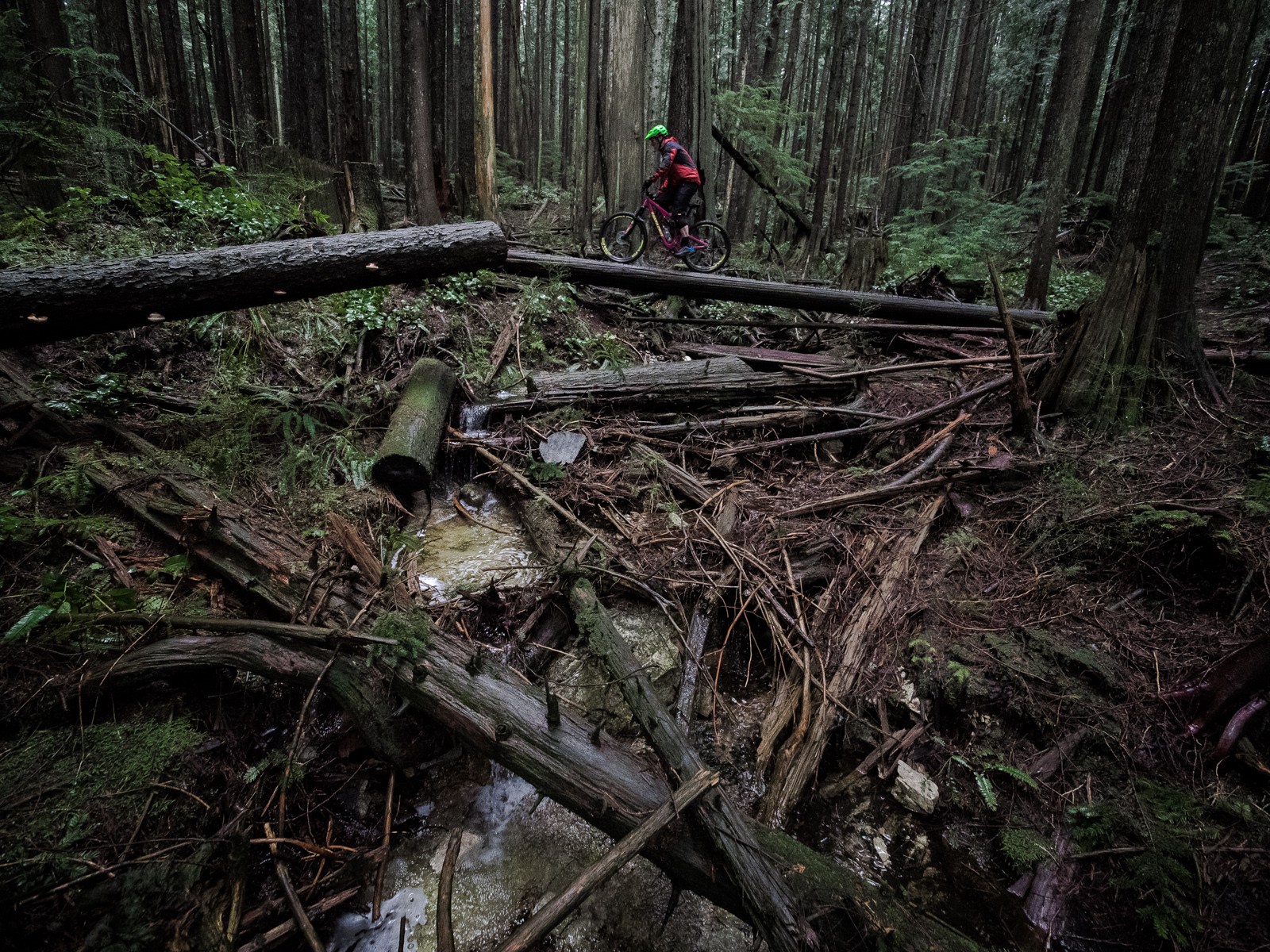
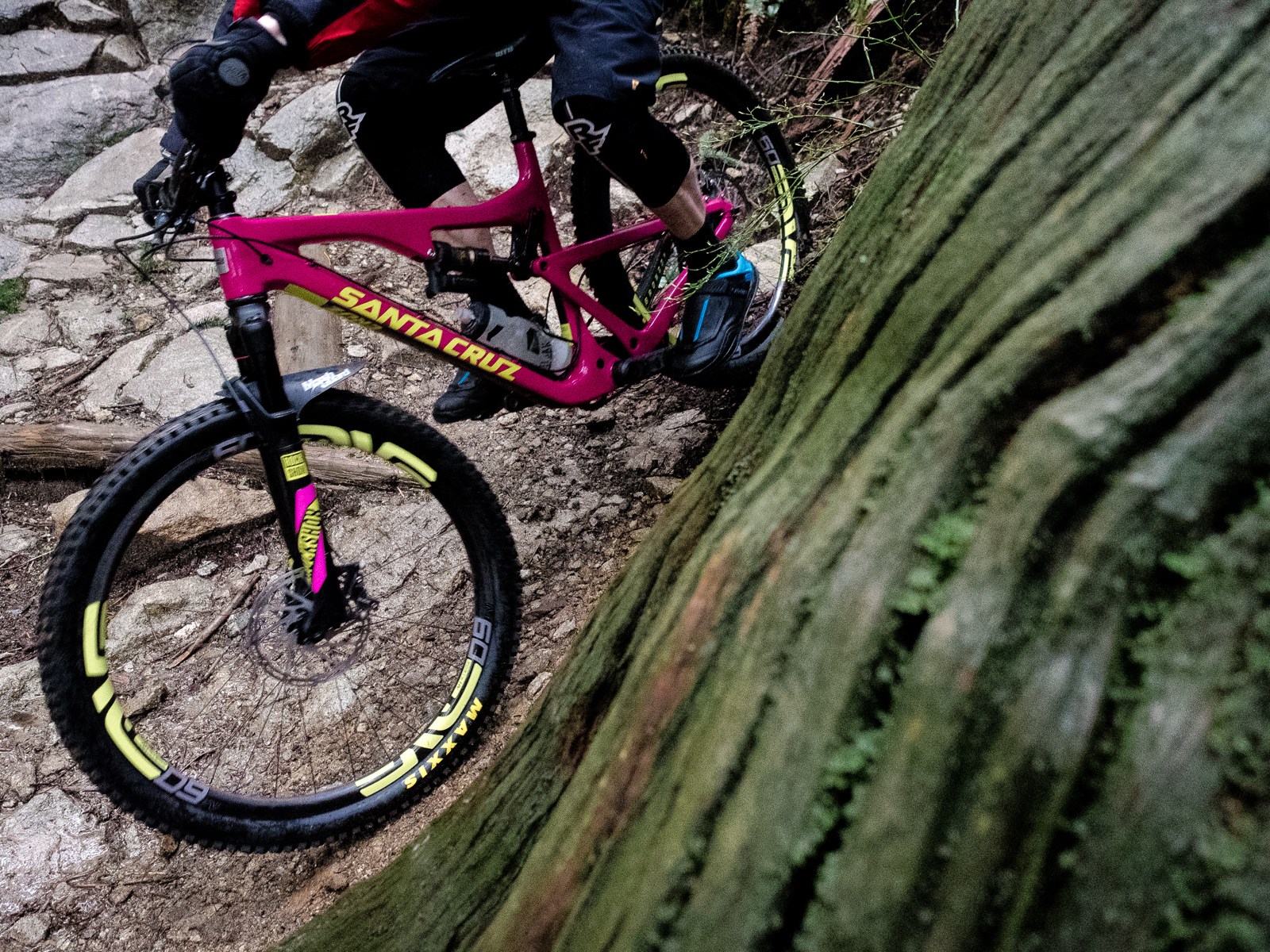

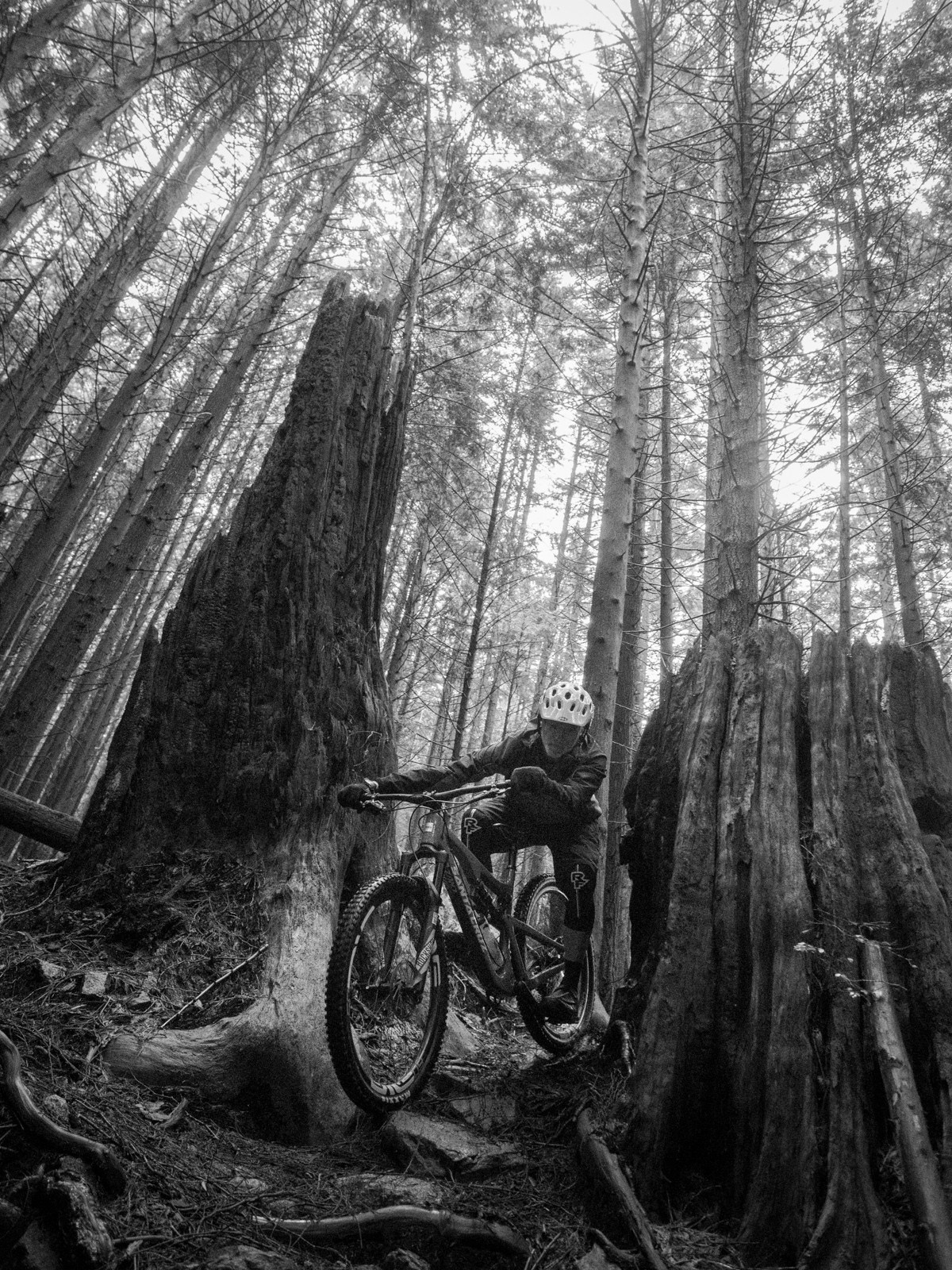
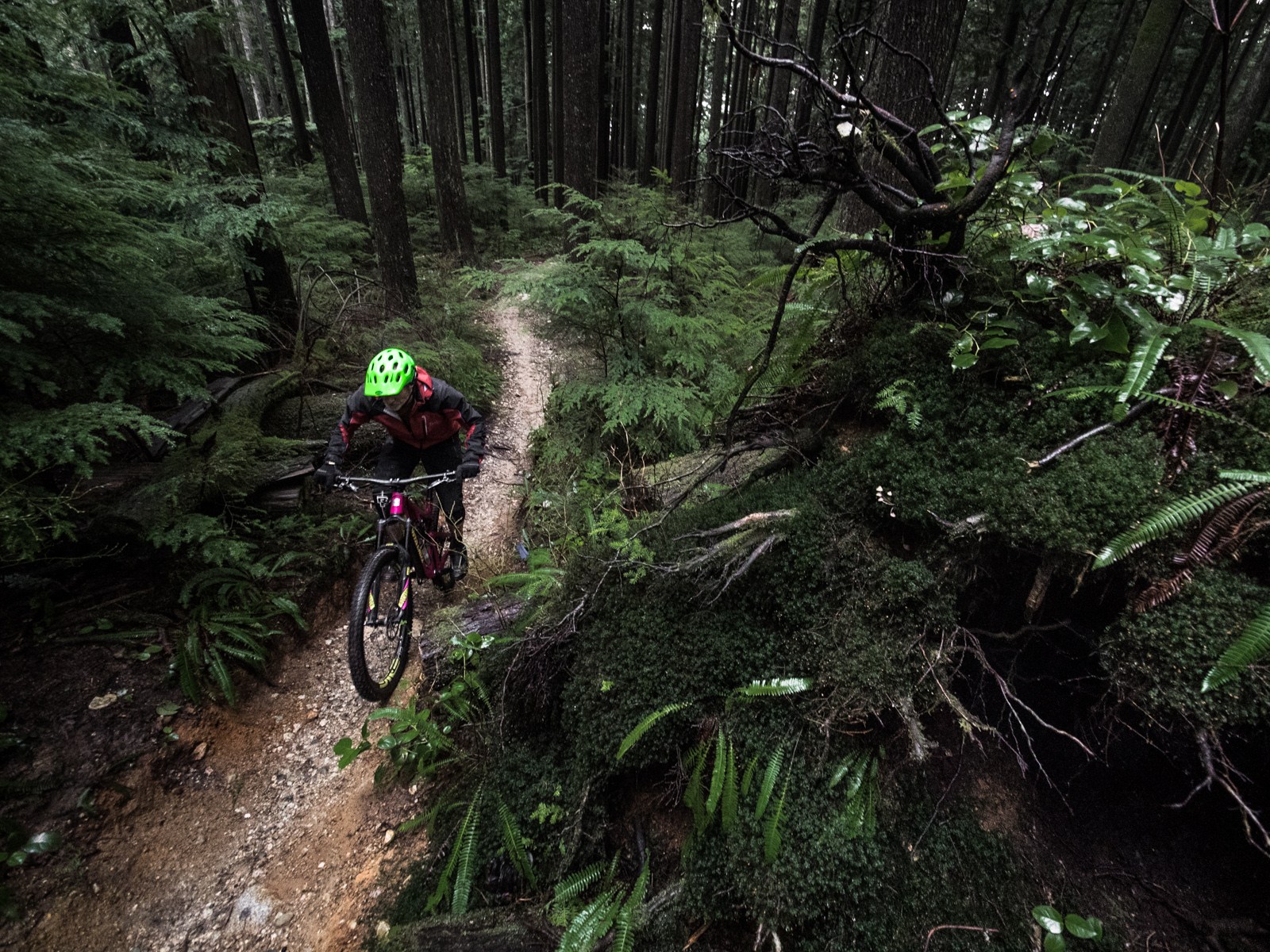
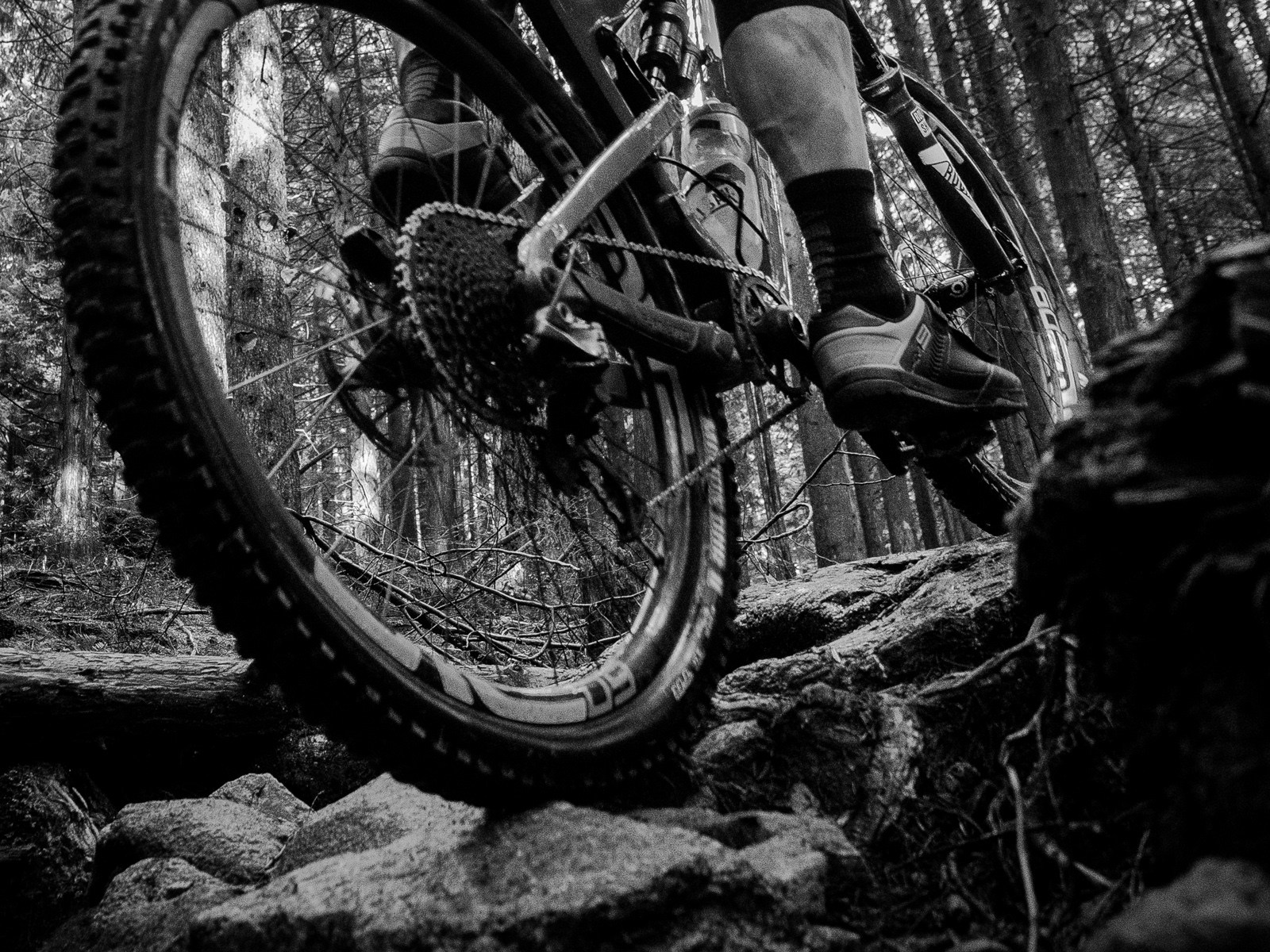


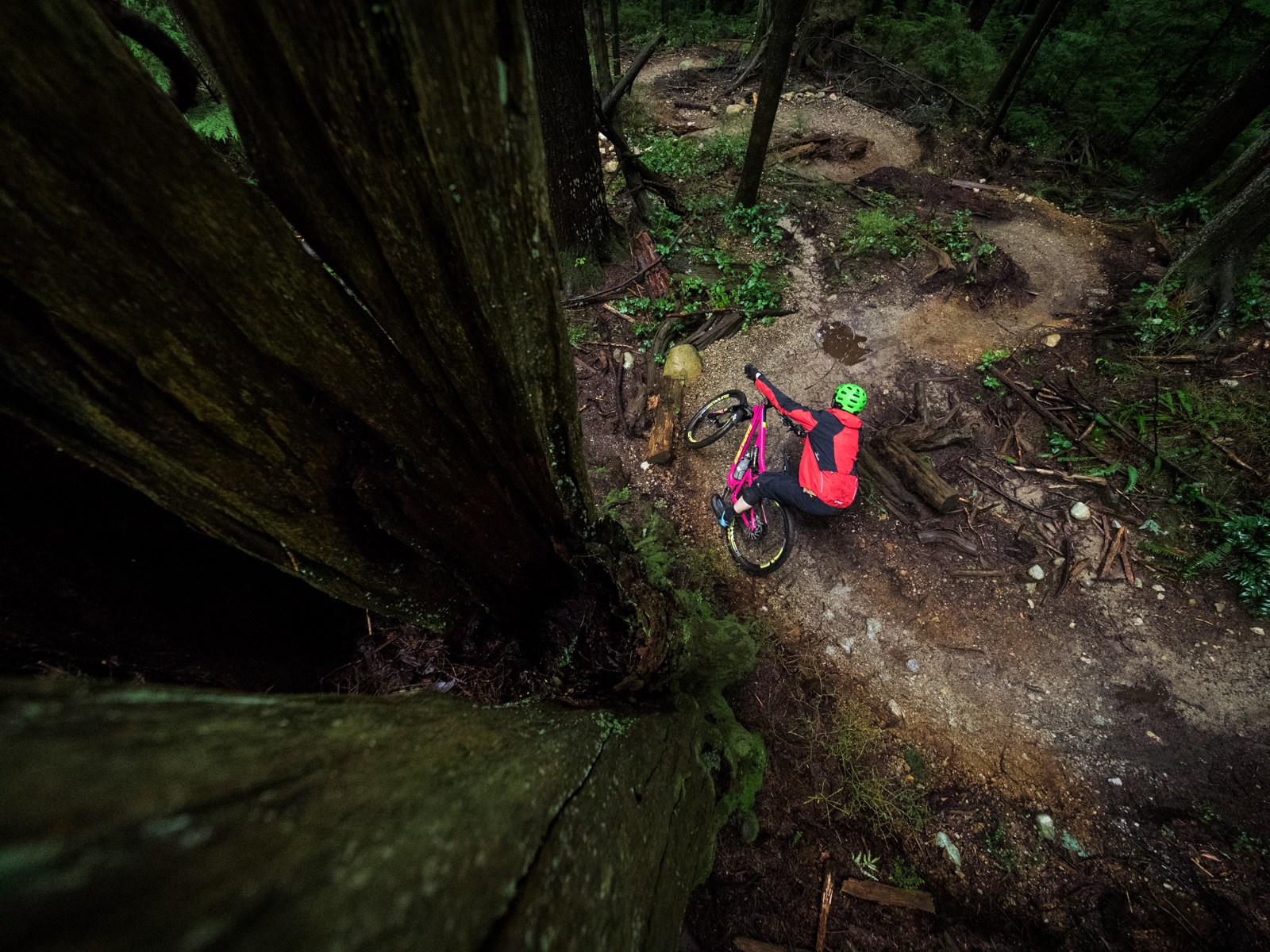
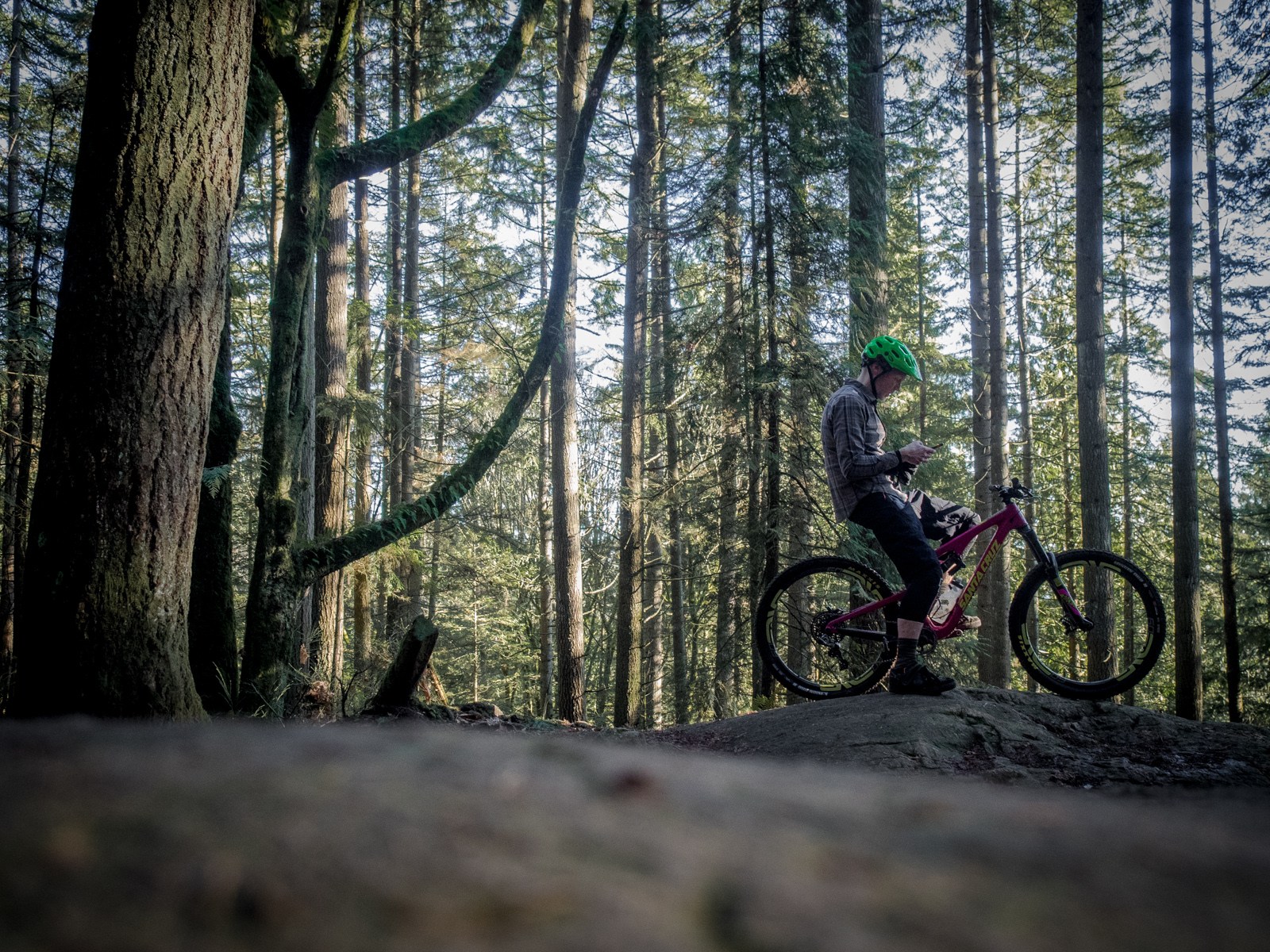







Comments
Mike Henry
8 years ago
When you said "Though our egos tend to drive us towards wanting the biggest gun in the arsenal (ie, the Nomad), methinks many of us would be better served on something like this" you caught my interest. Better served because it climbs that much better than a Nomad?
I've been thinking about a Nomad and waiting for the redesign. However, most of my riding is on the shore with just a few bike park days (whistler, sun peaks, coast gravity park). And when there, I prefer runs like crank it up to dirt merchant. Do you think a Bronson can handle laps on crank it up (with one or two A lines thrown in?). I'm not a super aggressive rider. Would a Bronson be a better bet for me?
Reply
Cole
8 years ago
Since you guys have a lot of time on the 2015 Santa Cruz Nomad as well as this bike, how would you say the two bikes compare? I'm currently riding a Nomad but I've bee considering selling the frame and swapping all the components over to a Bronson. I like my Nomad but it really likes to be pointed downhill. I find that I really fight the Nomad on flatter sections of trail or traversing across the mountain etc.
By switching to a Bronson, I'm hoping to sacrifice a little bit of downhill capability in order to have something a bit better all around.
Reply
Salespunk
8 years ago
I have both and you will get exactly what you are looking for. More pop and agility with the Bronson vs a DH bike that can climb anything with the Nomad.
They both solve the same problem but from two different angles. Each can be ridden over the same terrain, but will feel completely different. You can't attack the rougher DH sections with the Bronson like you can with the Nomad. The Bronson has more snap and pop in the corners and off of the side hits. One thing I have found with the Bronson is that you have to weight the front wheel. It does not like to be ridden from the back wheel BMX style.
Reply
Jamie Hamilton
8 years, 1 month ago
Yes! In recent years as technology & focus on good geometry etc have proven that you don't need the biggest gun to win the battle. Longer is not always better. It's all about how you use it. Bronson, shorter Processes, Pyga etc more like these please!
Reply
Nat Brown
8 years, 1 month ago
I really like this review Perry. Particularly how you give your subjective experiences, but give so much freedom to the reader to interpret those experiences and make their own conclusions.
Reply
Bryan Johnson
8 years ago
Agreed, this is how all reviews should be
Reply
Ted Roome
8 years, 1 month ago
The life time warranty extends to the entire frame so as long as your the original registered owner you can go back to SC for help. To me that is the outstanding feature of a 10 - 12K bike.
Perry, would you take the Bronson to Whistler BP?
Reply
Vik Banerjee
8 years, 1 month ago
SC offers free lifetime bearings. Warranties like the one SC offers on the frame itself are typically restricted to failures due to manufacturing defects. This is just a straight up free bearings for life [to the original owner] deal.
Reply
jonathan_kingstone
8 years, 1 month ago
An excellent, thorough review.
I have a v2 5010 and feel the description of the revised VPP is spot on here.
Reply
Oliver Burke
8 years, 1 month ago
How did you feel the Maxxis DHR 2 performed on the front? compared to say a DHF
Reply
Perry Schebel
8 years, 1 month ago
I liked it. seems like more steep braking grip at the expense of slightly more drift (in the wet) before the shoulder knobs engage.
Reply
Cam McRae
8 years, 1 month ago
DHR 2 on both ends is one of my favourite combos right now.
Reply
Tim Coleman
8 years, 1 month ago
I prefer the DHR 2 to the DHF on both ends as well, awesome tires!
Reply
AndrewR
8 years, 1 month ago
DHR2 front for better braking, DHF front for (slightly) better steering. Still don't roll, grip or last as well as a set of Trail Kings though.
Reply
Shrockie
8 years ago
On my 27.5″ Nomad I had a 2.3 DHF on the front for a bit and thought it felt squirrely compared to my 2.4″ 26″ DHF from my last bike.. so I just moved to a 2.5 WT DHF and it hooks up a lot better..
It's on a 25mm internal rim rather than the 32-36mm it's made for, but works well for me.. Now the 2.3″ HR2 in the back seems drifty.. Will put a 2.4 DHR2 on there to balance things out.
Reply
Shrockie
8 years ago
Cam, are you using the 2.3 DHR2 or 2.4 WT DHR2 like the test bike? I presume you're on 27.5″..
Reply
Oliver Burke
8 years ago
Ive got a Magic Mary on the front at the moment which has been amazing over the UK winter but want something that rolls better now its drying out. Thought about just staying with the Mary but the DHR 2 has been an amazing rear tyre. A lot lighter than a DHF as well so thought i might just go DHR 2 29 on the front as well
Reply
DJ
8 years, 1 month ago
colour is subjective. and i subject that to hideous. frighteningly so.
Reply
Please log in to leave a comment.